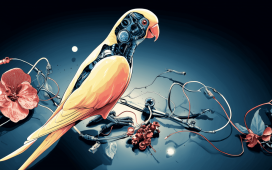
Trimming rose bushes in the garden. (Getty Images)
Q. Can you please tell me what my hungry visitors are? I counted six on my plant. I don’t want to pick them off if they are beneficial.
Those caterpillars are from the white-lined sphinx moth, a snazzy, Art-Deco-looking moth that is sometimes mistaken for a hummingbird (that’s why they’re called hummingbird moths). They are pollinators, so they are considered beneficial insects.
If you are worried about them eating too many leaves off your landscape plants, you can gently relocate them to another plant since they are not terribly particular about what they eat.
Q. When is the best time to prune my rosebushes? They never totally lose their leaves in the winter.
Although roses growing in warmer climates may not completely go dormant, they do slow down quite a bit. I like to wait until they stop blooming because that’s the closest thing to dormancy in Southern California. This is usually between the first week of December and the end of February but, realistically, you can prune them any time of the year here.
Q. Earlier this year, I had a problem with earwigs and slugs eating my seedlings. I made a bunch of beer traps, filled them with some cheap beer, and ended up trapping a lot of earwigs, pill bugs, and slugs. Now something is digging up my bean seeds, which I planted directly in the soil. There are many holes, about an inch across, exactly where my beans were planted. What could be eating my beans, and what can I do about it?
If the holes were larger (2-4 inches) and had little piles of dirt next to them, I would suspect gophers. The small holes could have been left by mice or voles. Voles (meadow mice) are like mice, but they have smaller ears, shorter tails, and are chubby and not as quick as field mice. My cats like catching them because they get more meat for less effort. Either rodent can cause problems in your garden.
Some gardeners have success with rodent repellents, but if the critters are hungry enough, they won’t be deterred by hot pepper dust, peppermint oil, or coyote urine. Placing mesh or smaller gauge chicken wire over the planted areas may prevent digging but might interfere with larger emerging seedlings.
Another possible culprit could be darkling beetles. These are similar in appearance to predatory ground beetles but are dull black (unlike the shiny black ground beetles). Unlike predatory ground beetles, they prefer to devour young seedlings instead of other bugs. They like to hide under leaf litter and heavy mulch, so removing this cover may discourage them.
Although the standard gardening advice is to direct seed beans and peas, you may have to resort to starting them indoors and letting them grow to a sufficient size that will make them less susceptible to being eaten.
Los Angeles County
mglosangeleshelpline@ucdavis.edu; 626-586-1988; http://celosangeles.ucanr.edu/UC_Master_Gardener_Program/
Orange County
ucceocmghotline@ucanr.edu; http://mgorange.ucanr.edu/
Riverside County
anrmgriverside@ucanr.edu; https://ucanr.edu/sites/RiversideMG/
San Bernardino County
mgsanbern@ucanr.edu; 909-387-2182; http://mgsb.ucanr.edu











